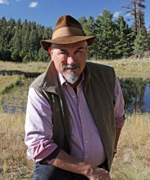 —Alan Dulaney
—Alan Dulaney
For central and southern Arizona, this has been the hottest summer on record. It has also been one of the driest. The eagerly awaited monsoon rains, which were so disappointingly scarce in 2019, proved even more elusive in 2020. This “non-soon” season had an impact on the electrical power grid; in mid-August, SRP, APS and Tucson Electric all called upon customers to reduce the demand on the system by turning up their thermostats (above 78 degrees) and conserving electricity. Even low-water use plants adapted to the desert were stressed. The Arizona Municipal Water Users Association ran a blog article on protecting plants during extreme heat through smarter watering practices.
ADWR discussed the situation in a recent article on their website. Forecasts from the National Weather Service envisioned a mix of warmer and cooler sea surface temperatures that they thought might lead to a more normal monsoon season (unlike the cooler SSTs that meant a dry monsoon for 2019). Obviously, that did not happen. What did happen was a large high-pressure dome that settled over Arizona and just would not go away. The high pressure prevented moisture from moving up from northern Mexico, touching off the expected thunderstorms of the monsoon season. High pressure also exacerbated the high heat, causing a record number of days over 115 degrees in Maricopa County.
This ups the ante for drought. In the most recent drought monitor report, some 82% of Arizona has moved into the severe drought category, and 42% of the state is now in extreme drought.
It is not clear that dry conditions could not linger into 2021. In early August, the National Weather Service predicted a 60% chance that SSTs might lead to a La Nina event, which is often manifested in decreased precipitation, for the Northern Hemisphere in the fall of 2020 and continuing on into the winter of 2021. Forecasts could still change, and an ENSO-neutral fall-winter and potentially a near normal monsoon, could still happen.
Normally, in August the water world is looking hard at the Bureau of Reclamation 24-month study, which predicts the water level elevations in Lakes Mead and Powell and thus determines the operations of these major reservoirs. The study has been released. Arizona will be in Tier 0 shortage for 2021, which can be successfully managed.
But the implications of increased heat and diminished precipitation can be seen in soil moisture levels. As the moisture levels decline, any water falling on or flowing over those dry soils will likely infiltrate to a greater degree. This leaves less water to join streams which eventually flow into the Colorado River and other major river systems. Lower reservoir water level elevations will inevitably result. Successful management will become far more difficult.
“It’s a dry heat,” we tell the visitors to Arizona during the summer months, and we smile at the astonished looks on their faces as they first encounter our blast-furnace weather. But hotter and drier are the continuing conditions of the future, and impacts on water resources won’t be a joke.